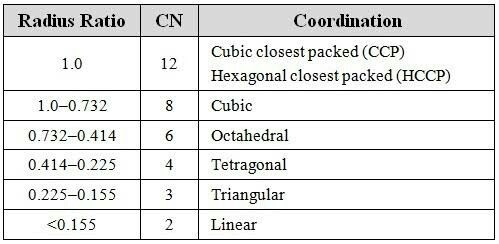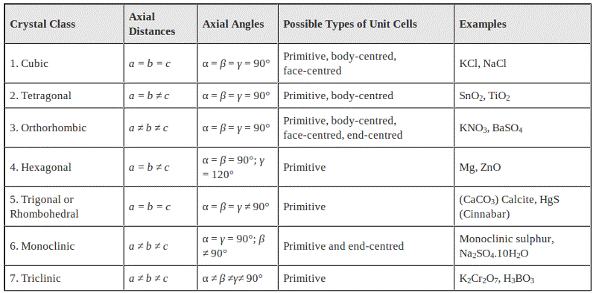Objective Type Questions and solutions for Class12
Multiple Choice Questions on Solid-State with answers and their explanation.
Prepared by Experts
Love to Learn
MCQs on Solid State Chapter -1
With answers and their explanation
Prepared by Experts
Question 1: In the compound RX, the radius of the R+ ion is 98 pm, and the radius of the X– ion is 184 pm. Find the crystal structure of RX and also give the coordination number of each of the ions.
- Octahedral, 6
- Tetragonal, 4
- Cubic, 8
- CCP or HCP, 12
Answer: The correct option is (a).
Radius ratio= r+/r– = 98/184=0.532
Given that the radius of R+ ion is 98 pm and the radius of X- ion is 184 pm. We have to find the radius ratio. Radius ratio is the ratio of the radius of cation to the radius of the anion. Hence, It is in the range of 0.414-0.732. Hence, the void is octahedral and the coordination number is 6.

Question 2: X has a simple cubic structure. The edge length of unit cell is 335 pm and its density is 9.27 g cm3. Determine the mass and predict what is ‘X’.
- 138, Ba
- 209, Bi
- 210, Po
- 96, Mo
Answer: The correct option is (c). Given that, X has a simple cubic structure. Its density is 9.27 g cm3 and its edge length is 335 pm.
Explanation
We know that
Z for simple cubic structure is 1,
M is the atomic mass of the compound=?
a is the edge length=335 pm
Na is the Avogadro constant is 6.022 × 1023
Density (d) =9.27 g cm3, To find: mass of the cubic crystal
d=(M× Z)/(a3 × N a )
9.27=(M× 1)/((335×10(-10) cm)3 × 6.022 × 1023 )
Hence, the mass of the cubic structure is
M=(9.27× (335×10(-10) cm)3 × 6.022 × 1023)/1
M=210
Hence the mass of the cubic structure is similar to the atomic mass of Polonium i.e. 210. Hence, ‘X’ is ‘Po’.
Question 3: A solid has three types of atoms P, Q, R in which P forms FCC lattice, R occupies all tetrahedral voids, and Q atoms occupy half of the octahedral voids. Predict the formula of solid.
- P2QR4
- P4QR2
- PQ4R2
- P4QR2
The correct option is (a). Given that P atoms are present in FCC unit, so,
No. of atoms = 1/8×8 +1/2×6=1+3 = 4
R atoms are present in all tetrahedral voids, no. of atoms = 8,
Q atoms are present in half octahedral voids,
No. of atoms = (Total no. of octahedral voids)/2= 4/2=2
So, the formula of the solid is: P4Q2R8 = P2QR4
Question 4: An element Barium has a BCC structure. Its density is 1.22gcm-3 and edge length is 512 pm. Calculate the packing efficiency for this unit cell.
- 74%
- 52.4%
- 68%
- 78%
Answer: The correct option is (c). Given that Barium crystallizes in BCC. We have to find the Packing efficiency of the Body-centered unit cell. In the case of Body Centred Cubic (BCC) lattice, the relationship between the edge length ‘a’ and the radius r of the unit cell is: a=4/√3 r
The volume of the unit cell is: As BCC unit cell contains 2 atoms per unit cell.
a^3=(4/√3 r)3=64/(3√3) (r)3
The volume occupied by one atom is: 4/3 π(r)3.
Packing efficiency =(Volume occupied by atoms in a unit cell)/(Total volume of unit cell) ×100
Packing efficiency (in %) =8/3 π(r)3/(64/(3√3) (r)3 ) ×100=(8π×√3)/64×100=(8×3.14×1.732)/64×100=68%
Hence, the packing efficiency of this unit cell is 68%.
Hence, the packing efficiency of this unit cell is 68%.
Question 5: Out of the following- Pick an example of Polar Molecular solid?
- SO2 (solid)
- H2O (ice)
- H2
- I2
Answer: The correct option is (a). Molecular solid are the solid having molecules as constituent particles. These are further divided in to three categories: Non-polar Molecular solids, Polar Molecular solids and Hydrogen bonded Molecular solids
- Non-polar molecular solid: In these solids atoms or molecules are held by weak dispersion forces or London forces. For example H2, Cl2, and I2
- Polar molecular solid: In these solids atoms or molecules are held by stronger dipole-dipole interactions. For example Solid SO2 and Solid ammonia
- Hydrogen bonded molecular solid: In these solids atoms or molecules are held by strong hydrogen bonds. For example H2O (ice)
Question 6: For the Hexagonal crystal system, axial lengths are and axial angles are. Choose the correct option to describe this system.
a=b=c; α= β= γ=900
a=b≠c; α= β=900 and γ=1200
a≠b≠c; α= β= γ=900
a=b=c;α=γ=900 and β≠900
Answer: The correct option is (b).
Question 7: Among the given statements, which one is incorrect about amorphous solids?
- Irregular shape
- They do not have definite heat of fusion
- Anisotropic in nature
- These are called pseudo solids
Answer: The correct option is (c). Amorphous solids are the solids in which constituent particles do not possess regular arrangement.
Characteristics of amorphous solids:
- Amorphous solids have irregular shape and they have short range order in arrangement of constituent particles
- They do not have definite heat of fusion
- They are also known as pseudo solids or super cooled liquids because of its tendency to flow.
- These are isotropic in nature as the properties like refractive index, electrical resistance show same values when measured along different direction in same crystals.
Question 8: Group 14 elements like germanium and silicon are doped with which group elements to form a p-type semiconductor. Choose the correct option.
- Group 13
- Group 15
- Group 17
- Group 18
Answer: The correct option is (a).
Doping can be done with impurity which is electron-rich or electron deficient as compared to the intrinsic semiconductor silicon or germanium. Such impurities produce electronic defects in them.
- Electron rich impurity: In this, group 14 elements (tetravalent) are doped with group 15 elements (pentavalent). So, the majority carriers are electrons and minority carriers are holes. Due to the presence of extra negatively charged electrons, the conductivity of doped silicon increases. Hence, silicon doped with an electron rich impurity is called an n-type semiconductor.
- Electron deficient impurity: In this, group 14 elements (tetravalent) are doped with group 13 elements (trivalent). So, the majority carriers are holes and minority carriers are electrons. Due to the deficiency of electrons and the presence of holes, the conductivity of doped silicon increases. Hence, silicon doped with an electron-deficient impurity is called a p-type semiconductor.
Question 9: Out of following-Which Stoichiometric defect is shown by AgBr. Choose the correct option?
- Schottky defect
- Frenkel defect
- Both Frenkel and Schottky defect
- Non-Stoichiometric defect
Answer: The correct option is (c). Schottky defects arise due to the missing of ions from their lattice point and Frenkel defect arise when the missing ions occupy interstitial sites. The radius ratio of AgBr is intermediate hence it shows both Frenkel and Schottky defects.
Question 10: Out of following: which one is right declaration about ferromagnetic substances?
- They contain no unpaired electron
- When they are placed in magnetic field they are oriented in the direction of magnetic field
- When they are placed in magnetic field they are oriented opposite to the direction of magnetic field
- Examples of ferromagnetic substances are NaCl, H2O and C6H6
Answer: The correct option is (b). Ferromagnetic substances are substances that contain a large number of unpaired electrons. When these substances placed in an external magnetic field, they are strongly magnetized in the direction of the field. Most of the ferromagnetic materials are metals. Examples of ferromagnetic substances are Iron, Cobalt, Nickel, etc.

